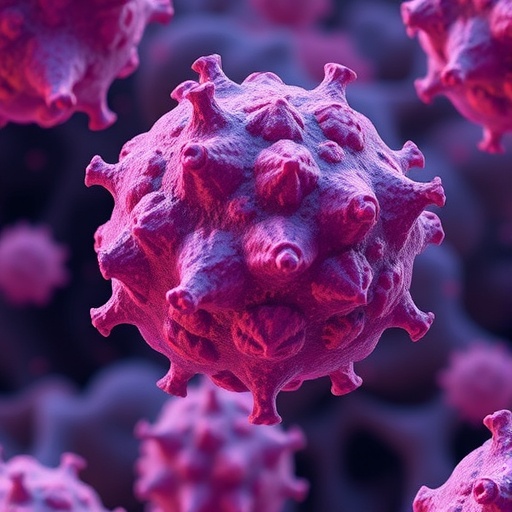In the relentless pursuit to comprehend the intricacies of cancer metabolism, recent breakthroughs have spotlighted a pivotal player: glutamine fructose-6-phosphate amidotransferase 1 (GFPT1). As the rate-limiting enzyme of the hexosamine biosynthetic pathway (HBP), GFPT1 assumes a central role in orchestrating the glycosylation of proteins, an essential post-translational modification that has profound effects on cellular signaling and oncogenic behavior. A newly published study in Cell Death Discovery by Sampson et al. unveils the elaborate metabolic signaling network governed by GFPT1, elucidating its deep-rooted interaction with prominent oncogenic pathways. This insight propels our understanding of how cancer cells harness anabolic processes to fuel their aggressive progression.
Anabolic metabolism, which supports the synthesis of macromolecules vital for cell growth, proliferation, and survival, is notoriously hijacked in malignant cells. Within this context, the HBP illustrates a critical reprogramming of cellular metabolism, converting glucose and glutamine into UDP-N-acetylglucosamine, a substrate instrumental for N- and O-linked glycosylation. The demand for protein glycosylation surges in cancer, influencing receptor tyrosine kinases, adhesion molecules, and immune checkpoint proteins that collectively shape tumor behavior. GFPT1’s function as a gatekeeper of this pathway underlines its significance, acting as a biomolecular bridge connecting nutrient availability, oncogenic signaling cascades, and metabolic flux.
The study by Sampson and colleagues provides a comprehensive mapping of GFPT1’s molecular interactions, revealing a sophisticated signaling web that includes kinase regulators such as AMPK, PKA, and mTOR complexes, along with transcription factors and immune modulators. This network positions GFPT1 as a nexus capable of integrating environmental nutrient cues with intracellular signaling, thus modulating metabolic programs necessary for cancer cell adaptability. Such intricate control mechanisms underscore GFPT1’s potential as a therapeutic target, given its influence over multiple oncogenic axes.
.adsslot_aknU7cFOEZ{ width:728px !important; height:90px !important; }
@media (max-width:1199px) { .adsslot_aknU7cFOEZ{ width:468px !important; height:60px !important; } }
@media (max-width:767px) { .adsslot_aknU7cFOEZ{ width:320px !important; height:50px !important; } }
ADVERTISEMENT
One of the salient revelations in this research is GFPT1’s dynamic phosphorylation by key metabolic sensors. AMPK, a master regulator that responds to cellular energy depletion, can suppress GFPT1 activity under acute nutrient scarcity, effectively throttling anabolic processes. Conversely, mTORC2, a complex known for its role in promoting growth and survival signals, can phosphorylate and sustain GFPT1 activity during prolonged nutrient stress, allowing cancer cells to maintain glycosylation-dependent signaling and anabolic throughput. This bidirectional regulation exemplifies the adaptability of metabolic networks in tumor cells under fluctuating microenvironmental conditions.
Further delving into the interconnectedness of signaling pathways, the researchers documented that GFPT1 interfaces extensively with the PI3K/mTOR and RAS/MAPK pathways—classical conduits of oncogenic signaling. These pathways not only drive cellular proliferation but also modulate metabolism, angiogenesis, and resistance to apoptosis. GFPT1-dependent HBP flux appears to feed back positively into these signaling cascades by supporting post-translational modifications essential for their function. This feedback loop amplifies oncogenic signals, supporting a tumor-permissive metabolic landscape.
Intriguingly, the Wnt/β-catenin and Hippo pathways, traditionally associated with stemness and organ size control, also intersect with GFPT1 activity. Modulation of GFPT1 impacts transcriptional programs governed by these pathways, which influences cell fate decisions and tumor plasticity. Such crosstalk positions GFPT1 at the heart of mechanisms that determine tumor heterogeneity and adaptive resistance, phenomena that complicate cancer treatment.
The study also highlights GFPT1’s involvement with immune checkpoint regulators, suggesting a role in modulating tumor immune evasion. Tumors often exploit glycosylation processes to alter the function or presentation of proteins such as PD-L1, dampening immune surveillance. By controlling HBP flux, GFPT1 may indirectly influence immune checkpoint activity, signifying its contribution beyond metabolism into the realm of tumor-immune interactions.
At the molecular level, GFPT1 phosphorylation by cAMP/PKA conveys a nuanced regulatory layer. PKA-mediated phosphorylation exhibits context-dependent effects, sometimes enhancing and other times attenuating GFPT1 enzymatic activity, thereby fine-tuning cellular responses to extracellular stimuli. This multifaceted control reflects the enzyme’s role as a metabolic rheostat, adjusting anabolic throughput in accordance with diverse signaling inputs.
Sampson et al. further provide compelling evidence that GFPT1-driven activation of downstream transcription factors orchestrates gene expression profiles supportive of metabolic rewiring in cancer. These transcription factors govern targets involved in glucose transport, lipid synthesis, and the synthesis of nucleotides, underscoring the broad reach of GFPT1 in cellular anabolism. Such extensive transcriptional control affirms GFPT1’s status as more than a mere metabolic enzyme but as a bona fide signaling integrator influencing cancer cell phenotypes.
In addition to biochemical assays, the study employs systems biology approaches to model the temporal dynamics of GFPT1 regulation under nutrient stresses. Short-term starvation predominantly invokes AMPK-dependent inhibition of GFPT1, a protective checkpoint conserving energy. However, under prolonged deprivation, mTORC2 activity rebounds, reinstating GFPT1 function to facilitate survival. This oscillatory response delineates a survival strategy enabling tumors to withstand adverse microenvironments, bolstering their resilience and capacity for progression.
Given GFPT1’s central role in converging metabolic and oncogenic signaling, its therapeutic inhibition emerges as an attractive avenue. Targeting GFPT1 could disrupt the glycosylation landscape fundamental to oncogenic receptor function, transcription factor activation, and immune evasion. Furthermore, its regulatory phosphorylation sites present potential allosteric targets amenable to finely tuned pharmacological modulation. Yet, the dualistic nature of its regulation cautions that therapeutic approaches must account for the context-dependent impact on tumor metabolism and survival.
As research advances, understanding GFPT1’s splice variants and isoform-specific functions may reveal further layers of complexity in tumor biology. Variability in expression and modification across cancer types might influence susceptibility to metabolic intervention, supporting a precision medicine approach. Additionally, the intersection of GFPT1-driven metabolic pathways with epigenetic regulation presents an uncharted territory warranting exploration, potentially linking nutrient sensing with chromatin dynamics in cancer.
The network-centric framework established by this study paves the way for comprehensive interrogation of metabolic signaling interdependencies. Integrating proteomics, phosphoproteomics, and metabolomics with functional genomics could yield predictive models of tumor behavior contingent on GFPT1 activity. This systems-level insight holds promise for identifying biomarkers indicative of metabolic vulnerabilities and therapeutic response.
In summary, the elucidation of GFPT1’s extensive signaling network redefines our understanding of how metabolic and oncogenic signals coalesce to empower cancer cell anabolism. By mediating critical cross-talk between nutrient sensors, growth factor pathways, and immune modulators, GFPT1 underscores the metabolic plasticity that drives tumor progression and therapeutic resistance. This groundbreaking research not only elevates GFPT1 as a linchpin in cancer metabolism but also as a beacon guiding next-generation strategies to combat malignancy through metabolic intervention.
Subject of Research: Cancer metabolism and signaling pathways focusing on the hexosamine biosynthetic pathway enzyme GFPT1.
Article Title: Exploring the metabolic signaling network of GFPT in cancer.
Article References:
Sampson, C., Li, P., Wang, Y. et al. Exploring the metabolic signaling network of GFPT in cancer.
Cell Death Discov. 11, 388 (2025). https://doi.org/10.1038/s41420-025-02687-3
Image Credits: AI Generated
DOI: https://doi.org/10.1038/s41420-025-02687-3
Keywords: GFPT1, hexosamine biosynthetic pathway, cancer metabolism, protein glycosylation, AMPK, mTORC2, oncogenic signaling, metabolic regulation, PI3K/mTOR, RAS/MAPK, Wnt/β-catenin, Hippo pathway, cAMP/PKA, immune checkpoints, transcription factors
Tags: anabolic metabolism in malignant cellscellular metabolism reprogrammingGFPT1 role in cancer metabolismglutamine fructose-6-phosphate amidotransferase 1hexosamine biosynthetic pathwayimpact of glycosylation on cell survivalmetabolic signaling networks in oncologynutrient availability and cancer progressiononcogenic signaling pathwaysprotein glycosylation in cancerstudy on GFPT1 and cancertumor behavior and glycosylation





